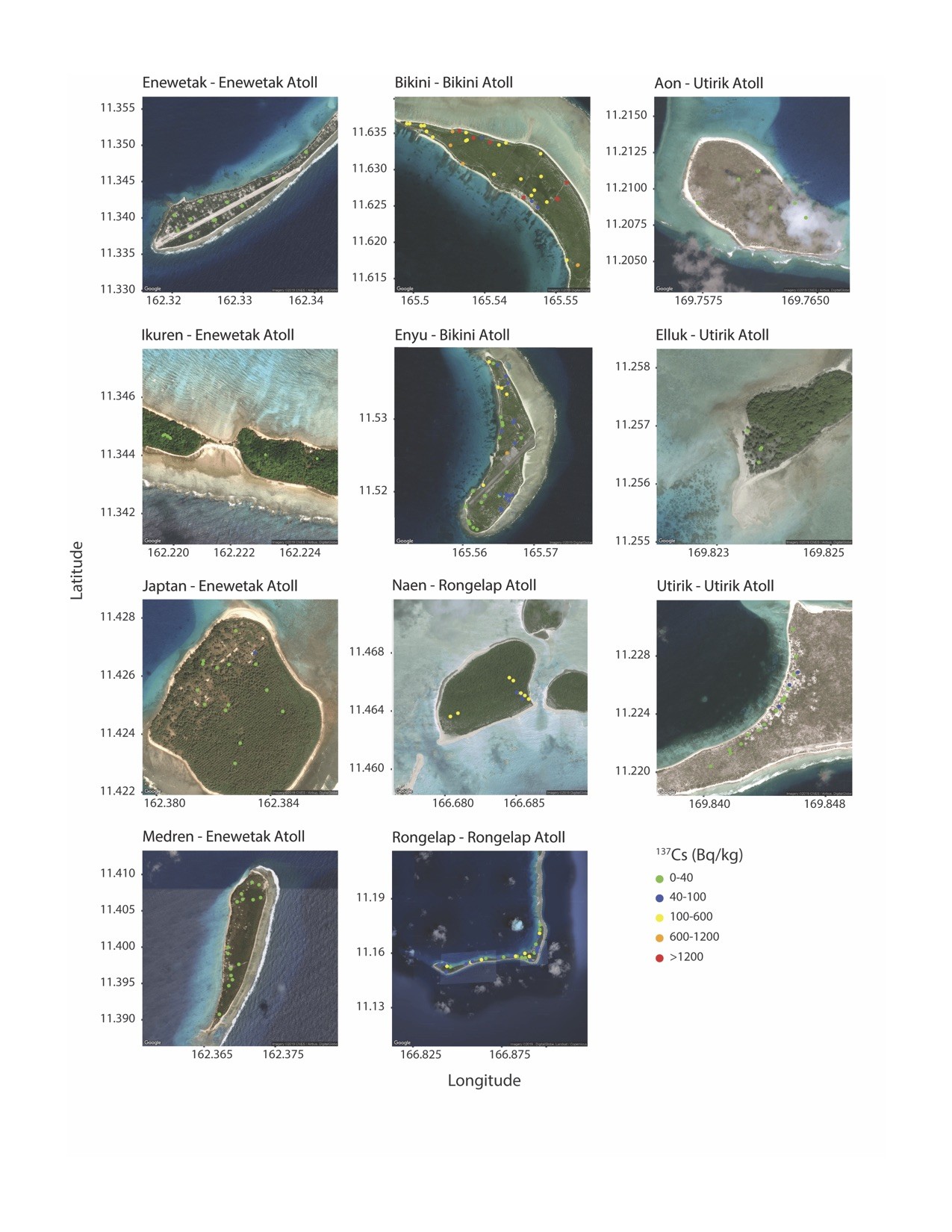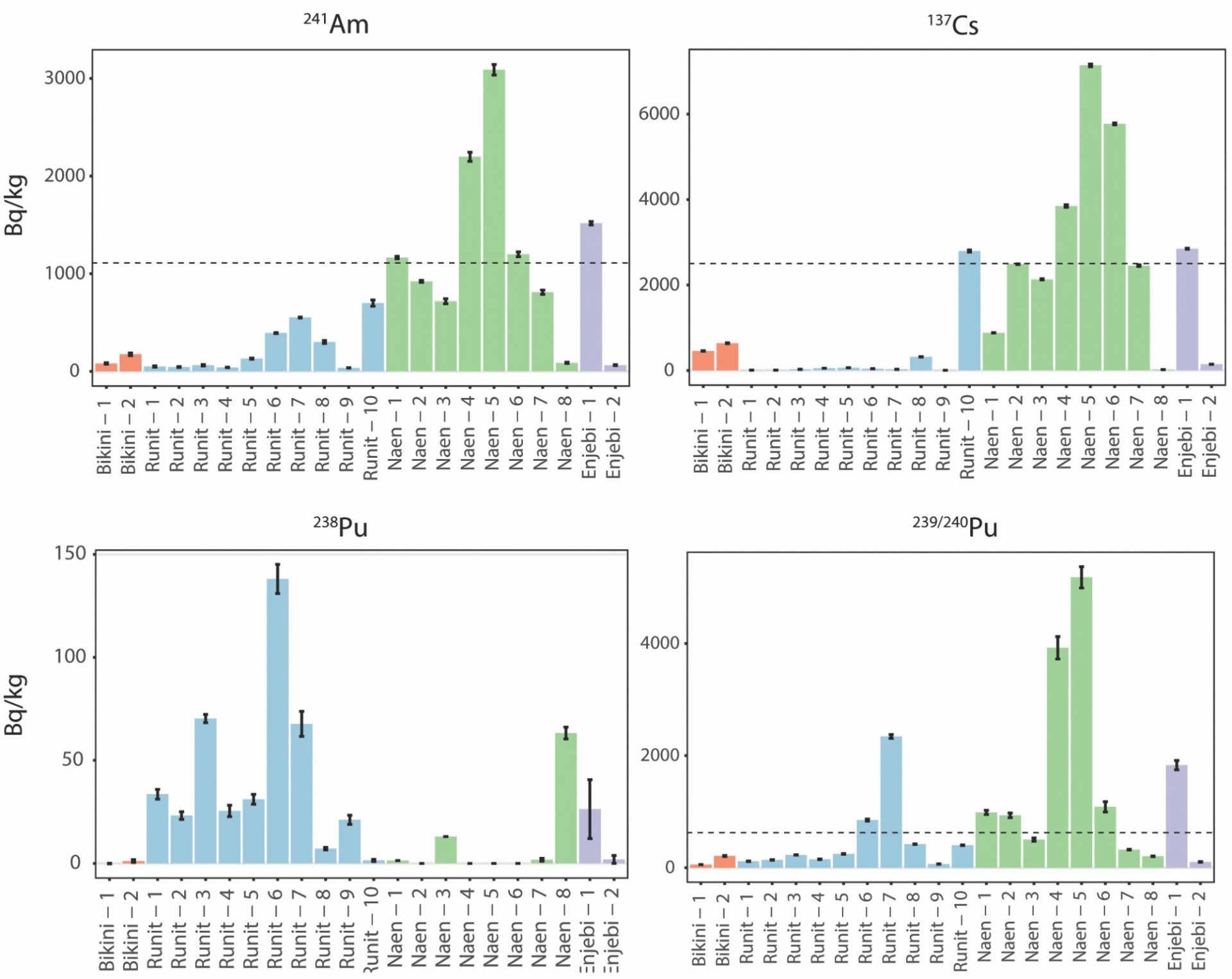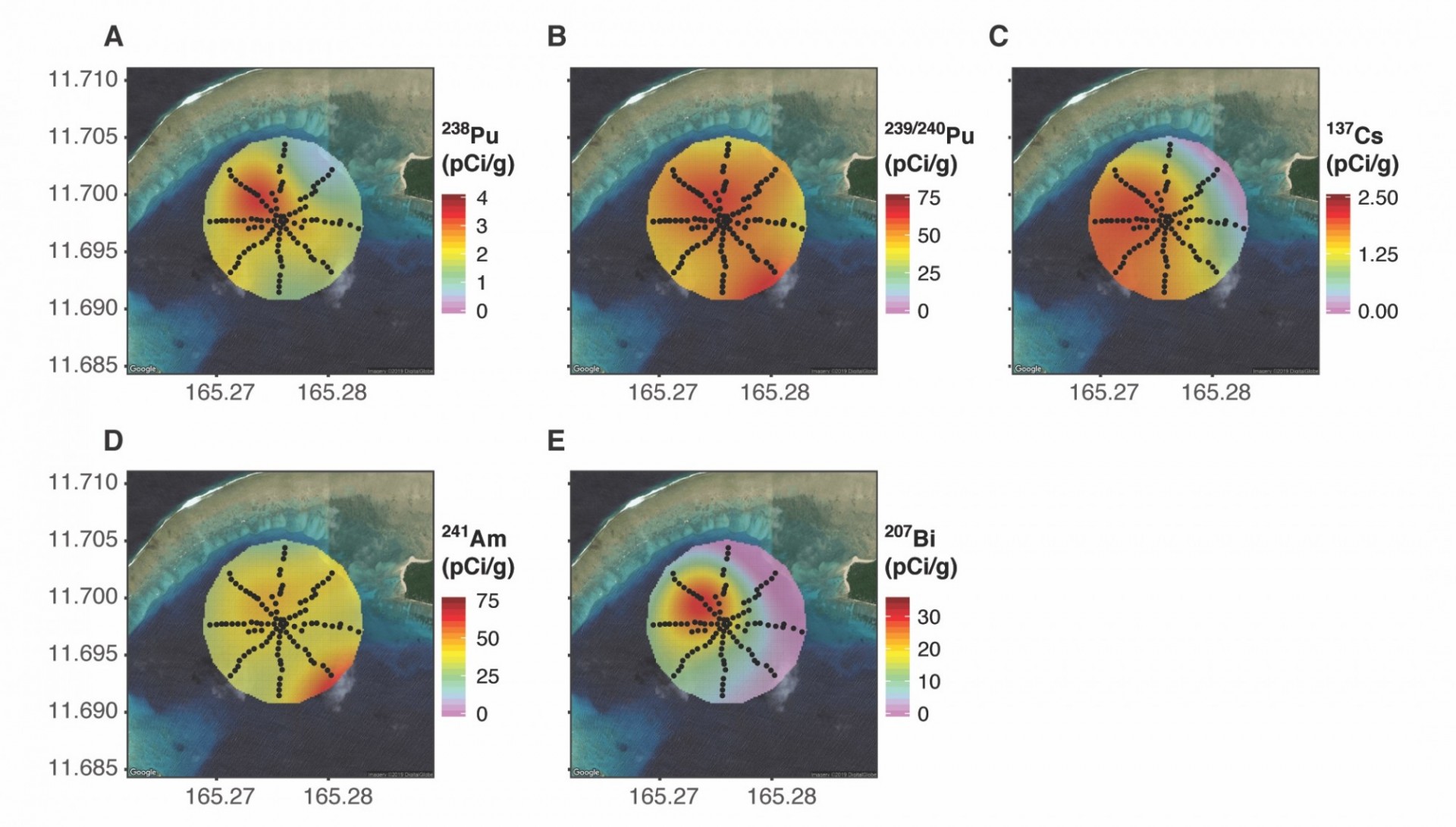In a series of studies conducted in the Marshall Islands in the midst of the Pacific Ocean, K=1 Project researchers found that the effects of the United States’ nuclear weapons testing remain apparent more than sixty years after the bomb detonations ended in the atoll chain.
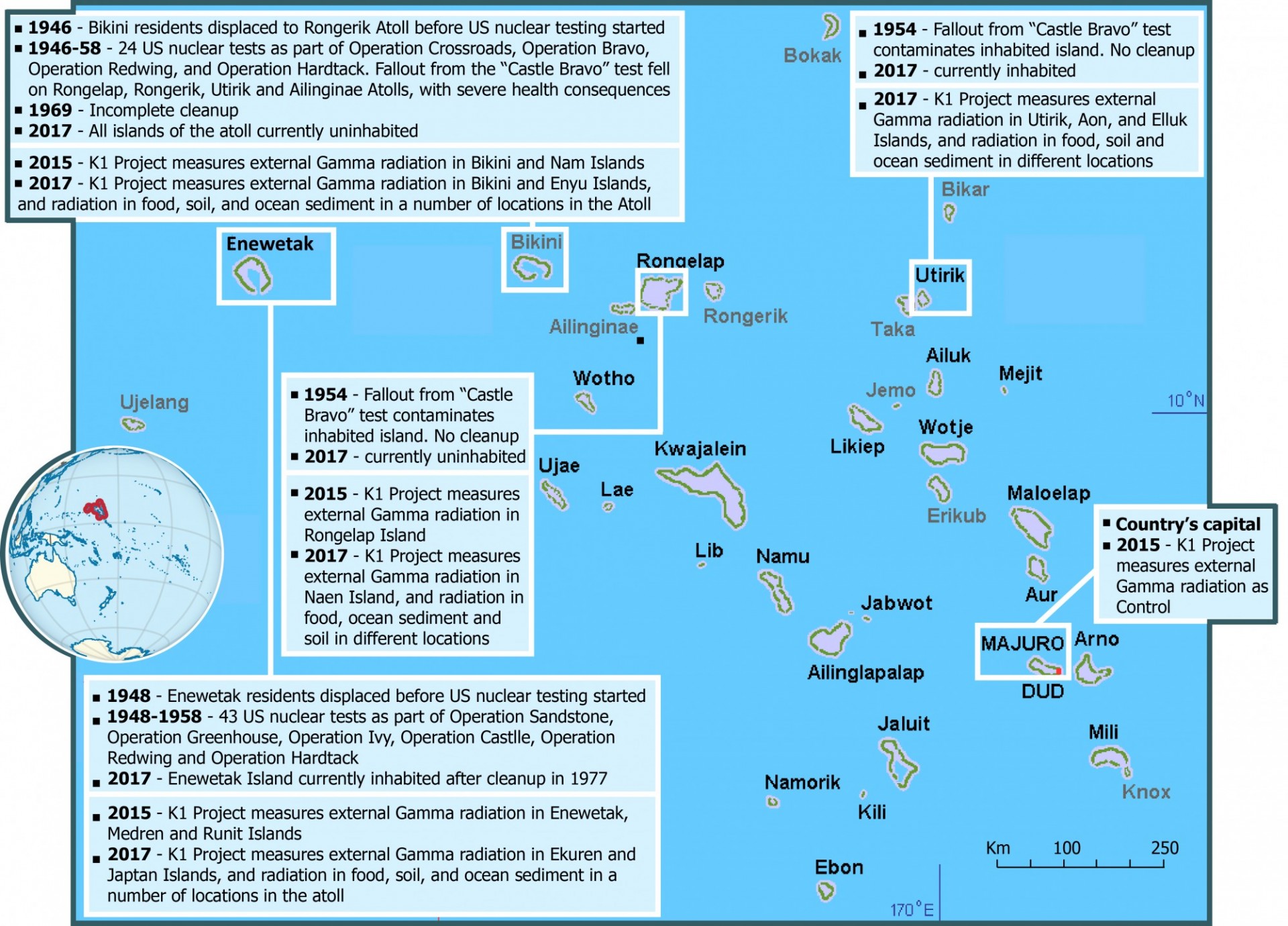
The United States’ involvement in the Marshall Islands is one that continues to impact the Marshallese people to this day. Though bomb detonations no longer occur, the remnants of the explosions—in the form of radioactivity and associated elements—still remain. American military personnel have also maintained their presence--the Army has a sizeable garrison on Kawjaelein Atoll.
Tests began shortly after World War II and continued into the late 1950s, with 67 total nuclear weapons (including the United States’ first and its most powerful thermonuclear bombs) being detonated over the course of the Truman and Eisenhower administrations. While the tests took place at a number of different sites, they were concentrated within two atolls: Bikini and Enewetak.
After the completion of the tests and continuing to this day there have been various cleanup and resettlement attempts. Bikini in particular was briefly resettled in the late 1960s, though this effort soon encountered the still-present dangers of radiation and was aborted by 1978. The Rongelapese people, who were exposed to radioactive fallout from the Castle Bravo test in 1954, faced a similar situation. They were initially moved away from their island, which is located about 100 miles away from Bikini, three days after the Bravo test. They were then resettled three years later, only to leave again for Mejato Island in 1985 amid concerns about the effects of lingering radiation on their health.
Utirik Atoll has a similar story—though with a more conclusive ending. Like Rongelap, residents were moved off the island two days after the Castle Bravo test and returned three months later. However, unlike for the other atolls, this resettlement was permanent.
Of the four most affected atolls, only Utirik has had a consistent population since the tests. While Enewetak is now also home to permanent inhabitants, these residents only returned to the island decades after the American nuclear tests had finished and a clean-up operation had taken place.
Resettlement efforts have been complicated by the wide dispersal of radiation from the mushroom clouds produced by the original explosions. Ranging in size up to more than twenty miles tall and four miles wide, these clouds—especially when carried by the wind—brought radionuclides to islands far beyond the immediate testing locations.
Based on trips to the Republic of the Marshall Islands (RMI) and collaborations with local officials, divers, and navigators and using three different approaches to examine the conditions of the islands today, we demonstrate that the extant radiation and radionuclides is apparent in several ways. One study measured cesium-137 contamination in fruit collected across islands in four northern atolls, another inspected soil radiation content and external gamma radiation also from islands in four different atolls, and the third surveyed ocean sediment from the Castle Bravo test crater.
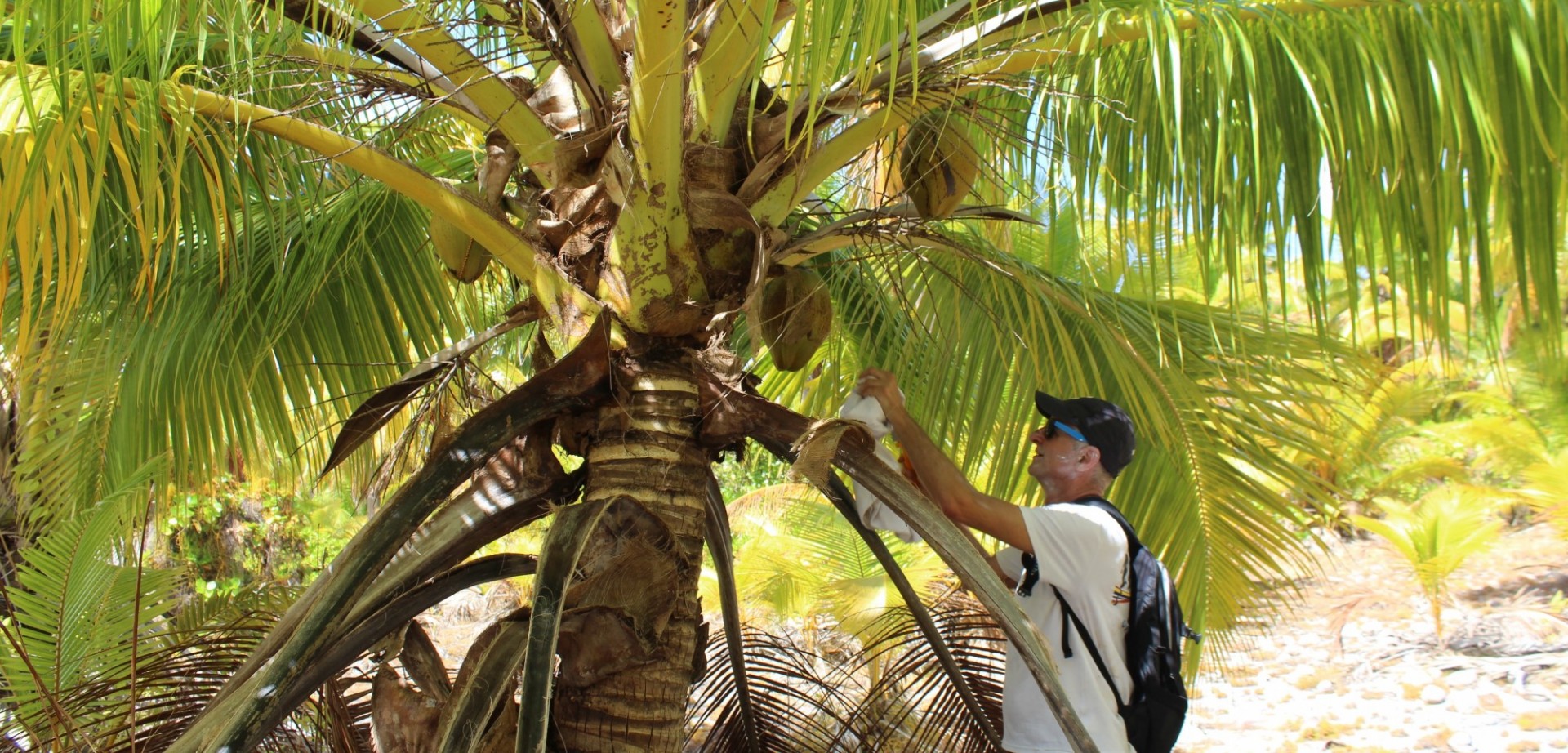
Contamination in Local Fruit
Perhaps unsurprisingly, the data demonstrated increased radiation contamination levels consistent with nuclear tests performed in the area in the 1940s and 1950s. For example, a number of fruit samples collected from within Bikini Atoll (which contains the Castle Bravo test crater) surpassed in certain cases the allowed or recommended cesium-137 content, in units of Bq/kg (becquerels/kilogram), as determined by a number of relevant national and international authorities, including the European Union and Food and Drug Administration.
Because of the wide variety of worldwide standards in regards to allowed cesium-137 content—especially when taking into account the variation in cesium-137 content between samples—it is difficult to precisely classify the danger that exists solely because of contamination in fruit of this type. The vast majority of tested fruit on Bikini Island, as well as Naen Island in Rongelap Atoll, falls afoul of the standards set by Japan, Russia, Belarus, and Ukraine, though not the more permissive guidelines of the FDA. However, some of the samples taken on Bikini Island have much higher cesium-137 readings, surpassing even the FDA standard.
There is also good news: many of the other islands do have low concentrations of cesium-137 below national and international standards. This is tempered by the results and their implications for the resettlement of Bikini and Naen specifically. As reinhabiting these islands would surely involve consumption of local fruit, elevated radiation levels continue to pose a roadblock to a safe permanent relocation of the former residents and their descendents.
Gamma Radiation Remains Present in Soil
Another study measured external gamma radiation and extant soil radioisotope concentrations on a number of islands. Similar to the results found in the collected fruit, a number of islands showed high levels of gamma radiation as measured in milirems/year (mrem/y). On Bikini Island, for example, measurements taken on-site around the island showed values of up to 640 mrem/y in areas near the island’s center. On Naen, an island in Rongelap Atoll, readings of over 300 mrem/y were recorded in much of the island’s investigated landmass. These results were both significantly higher when compared with Majuro Island, which was chosen to be the control. They also exceed the limit of 100 mrem/y set in the Memorandum of Understanding between the United States and the RMI for total exposure of residents to radiation stemming from nuclear testing.
The study also measured concentrations of radioisotopes across the atolls—and Naen again stood out with comparatively high measurements of plutonium-239/240, as well as americium-241. The highest levels of these isotopes found on Naen were, in some cases, more than double those found on any other island. One exception was plutonium-238, as Runit Island (home to the nuclear waste repository) instead had average concentrations higher than any of the other islands.
Much as was found with measurements of cesium-137, there was also positive news—especially in regards to Utirik Atoll. Even though this atoll was exposed to fallout and radiation from the Castle Bravo test in 1954, all three islands tested within the atoll had radiation that was not measurably higher than that of Majuro.

Castle Bravo Crater Shows Signs of Radionuclides
While two of the studies examined islands that had been adjacent to or farther away from the explosions, the third directly inspected a crater created by a number of bombs, including the 1954 Castle Bravo test which topped out at a yield of 15 megatons of TNT equivalent. Ocean sediment samples were collected at depths of up to 60 meters by divers and subsequently prepared for analysis at Columbia University.
By mapping readings of various radionuclides collected from the ocean sediment samples onto location measurements by GPS, a clear picture of the precise radioactive remnants begins to emerge. Specifically, much of the radionuclide material tends to be located in the western portion of the crater, with more equal distributions in the cases of plutonium-239/240 and americium-241. In comparison to results collected from outside of the main crater, some of the radionuclides—especially plutonium-239/240, americium-241, and bismuth-207—show higher activity concentrations up to multiple orders of magnitude in units of picocuries per gram.
While it is more preferable to have high activity levels of radionuclides within a deep crater (even if that crater is near a formerly populated landmass) rather than directly on an inhabited island, there is still danger that could result from such radioactivity. For instance, ocean ecosystems could still be disrupted by the high levels of radiation even if humans do not directly interact with the area around the crater. Furthermore, owing to the fact that half-lives for some of the more active radionuclides reach from the hundreds to the thousands of years, the crater could still remain dangerous to humans long after the bomb tests have faded from living memory. Efforts must be taken to ensure that the effects of this radioactive contamination are monitored in the future.
What does this mean for currently inhabited islands?
Thankfully, there is positive news for some of the islands that are currently inhabited. Majuro Island, the capital of the Marshall Islands, did not show signs of any of the radionuclides that were detected in most of the other locations, which is comforting given its location in the southern Marshall Islands and a distance of over 500 miles from Bikini Atoll. Similarly, Utirik Atoll, which is inhabited, had low readings of external gamma radiation, soil isotope concentrations, and cesium-137 levels in the food. However, due to the limitations in study sample size, which is compounded by the vast array of islands that exist across the nation, continued monitoring is necessary to ensure safety.
In addition, some of the data demonstrate the success of previous cleanup efforts. In particular, the southern (populated) islands of Enewetak Atoll are noticeably less radioactive than their northern counterparts—in line with the history of cleanup work. Preliminary data from one northern island in Enewetak, Enjebi, suggest high external gamma radiation readings and soil isotope concentrations. Runit, the location of the concrete Runit Dome—which covers a vast nuclear waste repository--has similar radiation concerns.
All three of our studies demonstrate that even decades after the tests, evidence of the dropped bombs still remains in the form of radioactivity that could potentially endanger long-term residents and affect the surrounding ecosystems. Owing to this reality, mitigation and monitoring efforts are vital to ensure that displaced populations can return to their islands and that others already living in affected areas in the Marshall Islands do not continue to suffer the consequences of misguided testing. The danger of radiation must be contained as effectively as possible to ensure long-term health and safety of the Marshallese people.

